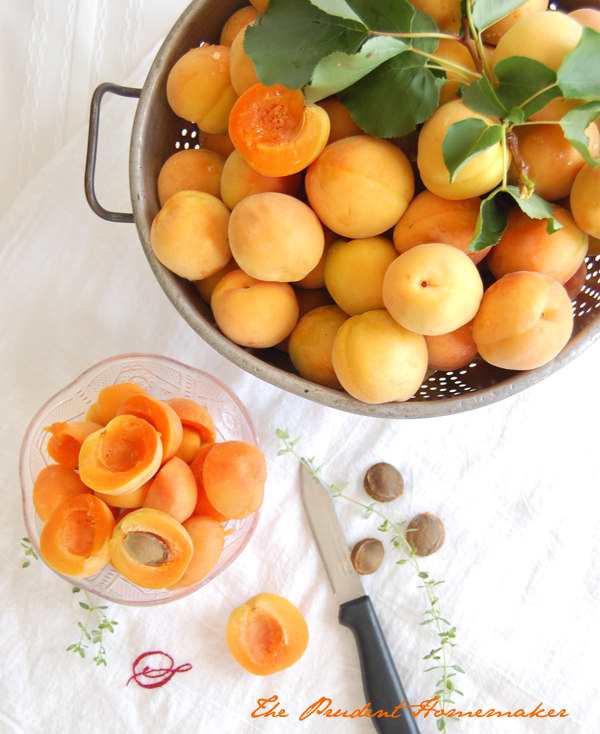
The two most common complaints I hear people give about their home-grown fruit is that the tree produces fruit that is too small, and that the tree only fruits every other year.
Both of these problems are easily solved by thinning.
A tree naturally thins itself, to some degree. Wind helps with this, knocking down some of the young fruit.
Thinning your fruit is a very important step in the long-term health of your tree. A tree that isn’t thinned can become exhausted, and be unable to bear fruit the next year.
When fruits are dime-sized, go out the tree with a ladder and a basket, and thin your trees. It will hurt your feelings to do this, You will feel like you are making less fruit for yourself, but that is not the case at all. You are allowing your tree to make bigger fruit, and you will give it the strength to fruit every year.
You’ll prevent your tree from losing branches due to being too heavily laden with fruit. Broken branches result in disease and bugs entering your trees, as well as a loss of fruit from the tree in years to come. Small, young branches with too much fruit at the tips cannot support the weight of fully-ripened fruit. Thin young branches and branch tips more heavily to prevent branch breakage.
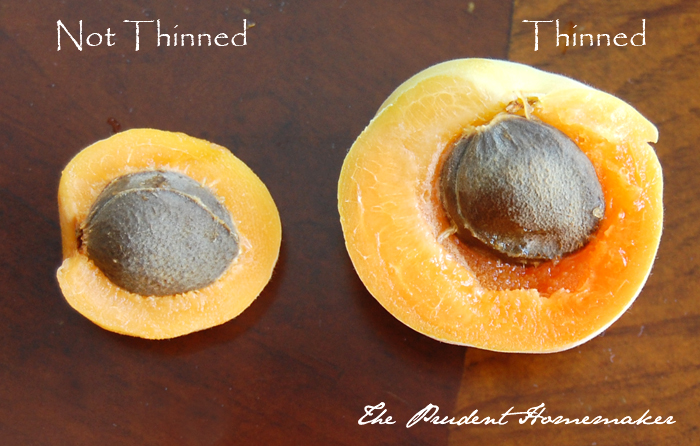
Thinning fruit also greatly affects the size of this year’s fruit crop.
You’ll want the fruit to be able to get sunlight and air around each piece so that it can ripen fully.
Stone fruits, including apricots, peaches, plums, and nectarines should be thinned. Apples and pears also need to be thinned. Citrus trees do not need to be thinned, as they naturally thin themselves, dropping enough “extra” fruit on their own. Figs naturally grow spaced apart from one another and do not need to be thinned.
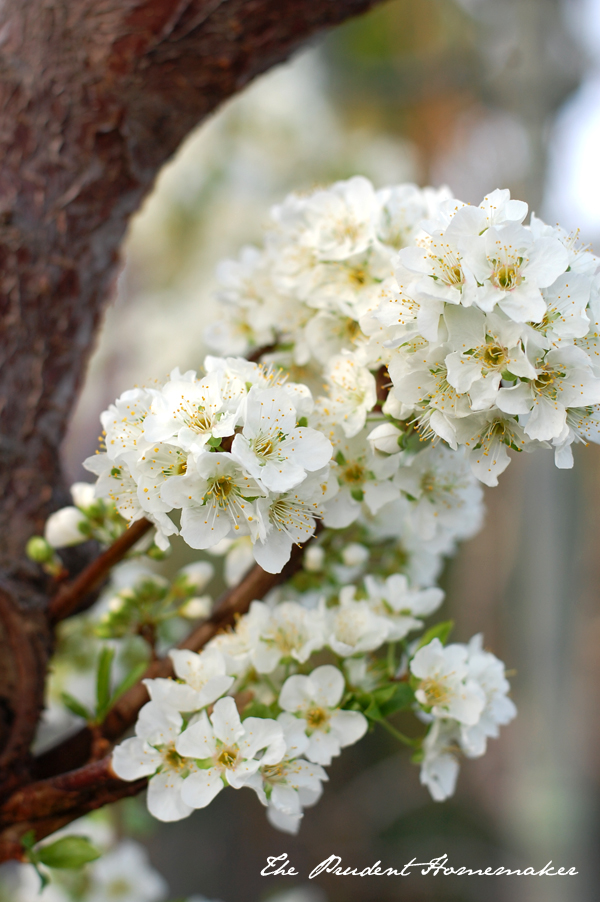
Apricots and Plums:
You’ll want your fruit to be 3″ (6-7 cm) apart. Pick off any fruit that is growing closer than this.
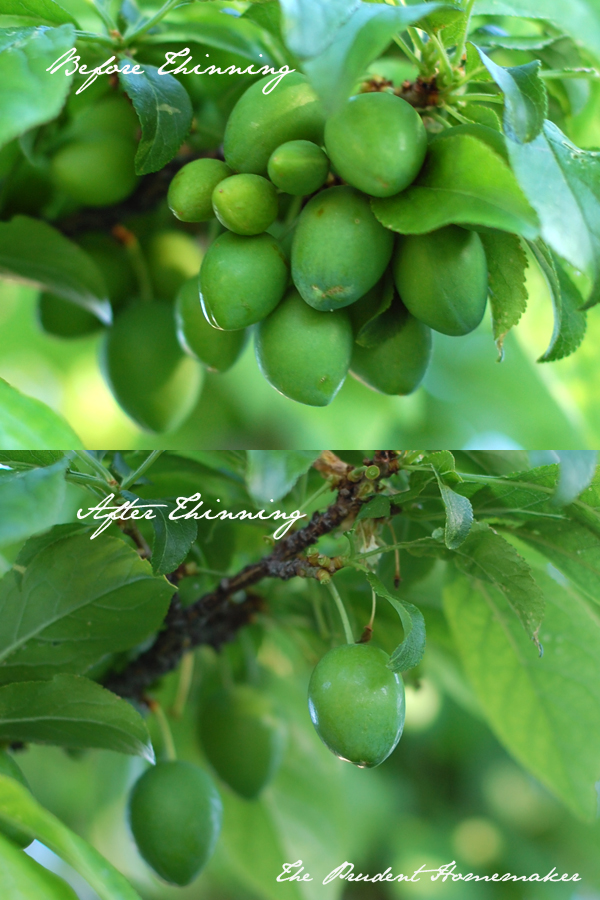
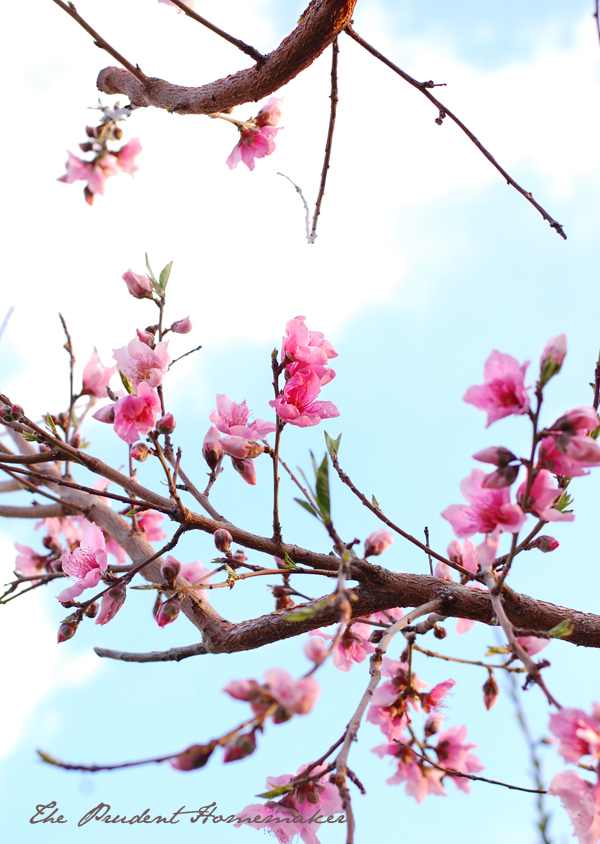
Peaches and Nectarines:
You’ll want your fruit to be 5″ to 6″ apart. Pick off any fruit that is growing closer together than this.
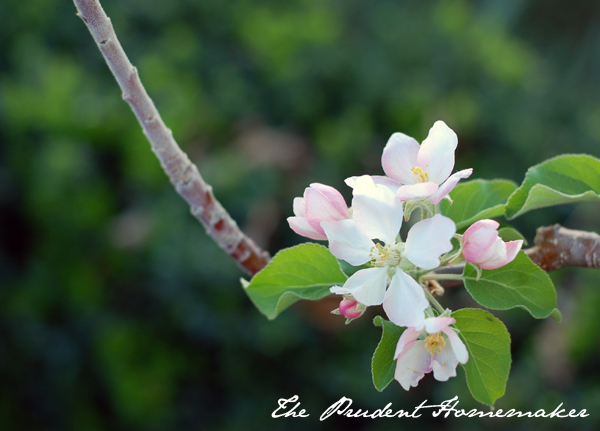
Apples:
Apples flower in a group, with the center flower usually opening first. This usually results in the center fruit being already larger than the others, as it had a slight head start on the other fruits in the cluster. When the apples are 1 to 1 1/2″ long, carefully pull off all of the fruits in each cluster except for the largest one.
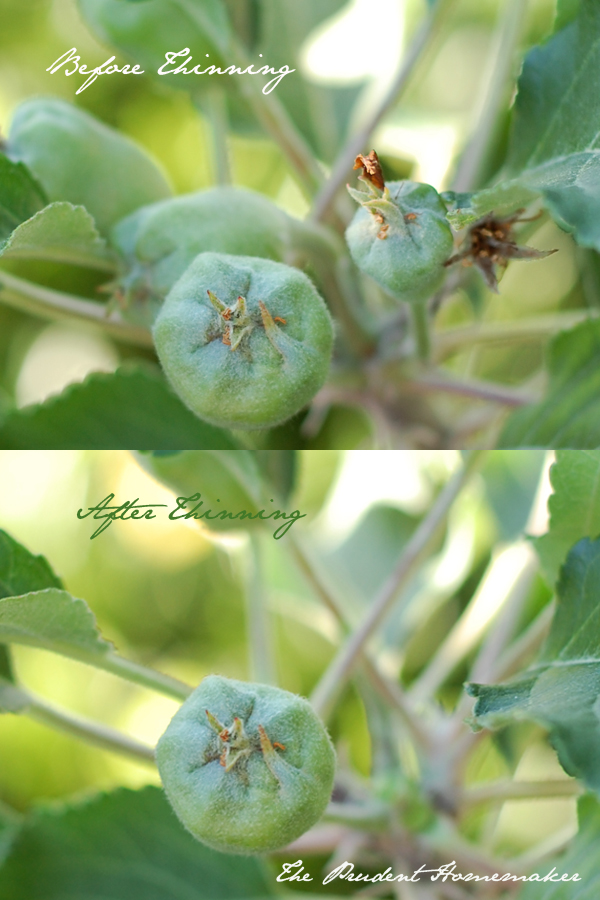
Pears:
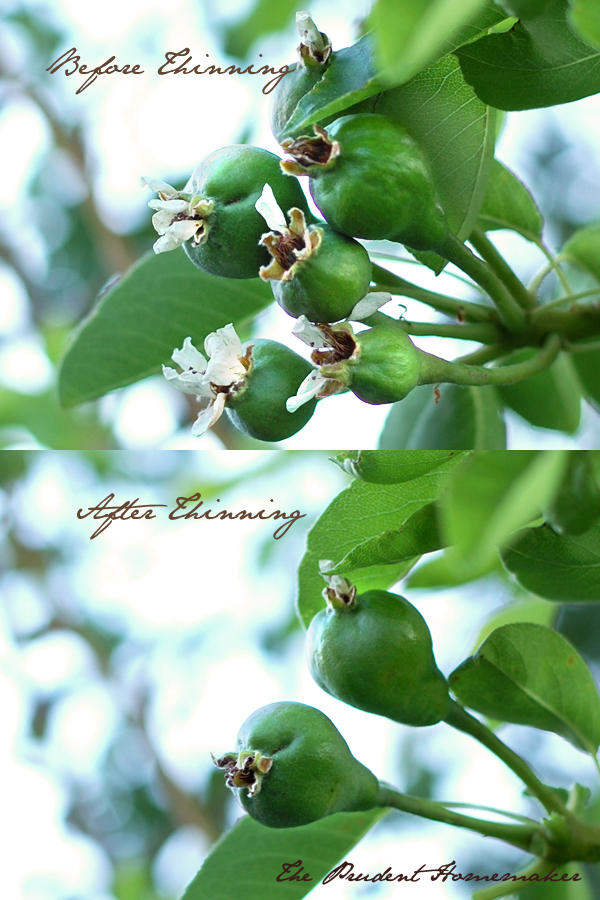
Like apples, pears should be thinned to one or two fruits per cluster.
When choosing which fruits to thin, make sure to thin any diseased fruit. Leave the largest and best-looking fruits on the tree.
Discard the fruit that you have picked. Leaving it on the ground (or any other fruit on the ground, later in the season) gives pests a good feeding ground and can introduce bugs to your trees. For this reason, I like to pick with a basket to collect the thinned fruit.
Don’t be afraid to thin your fruit! You’ll have much larger, healthier fruit and trees for years to come.

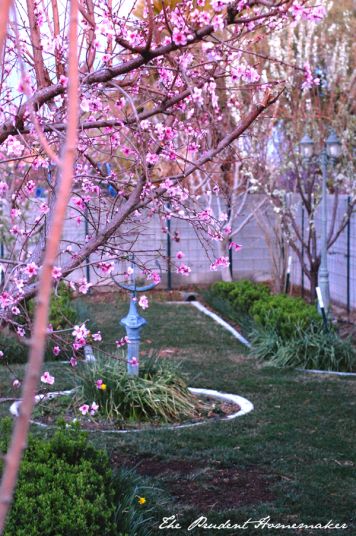
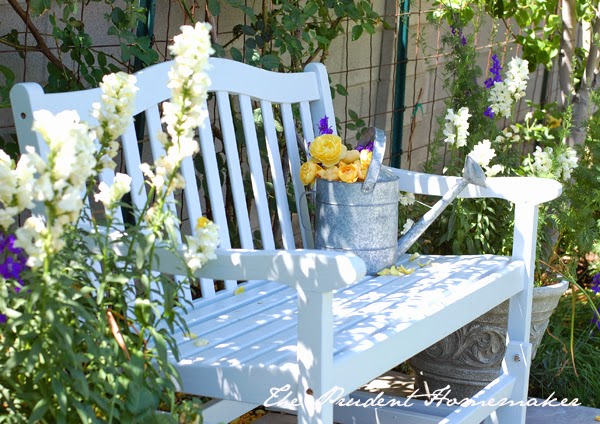
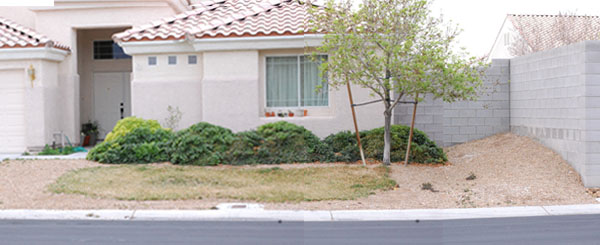
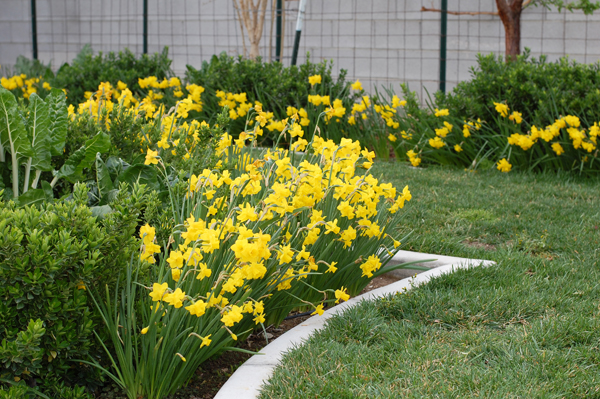
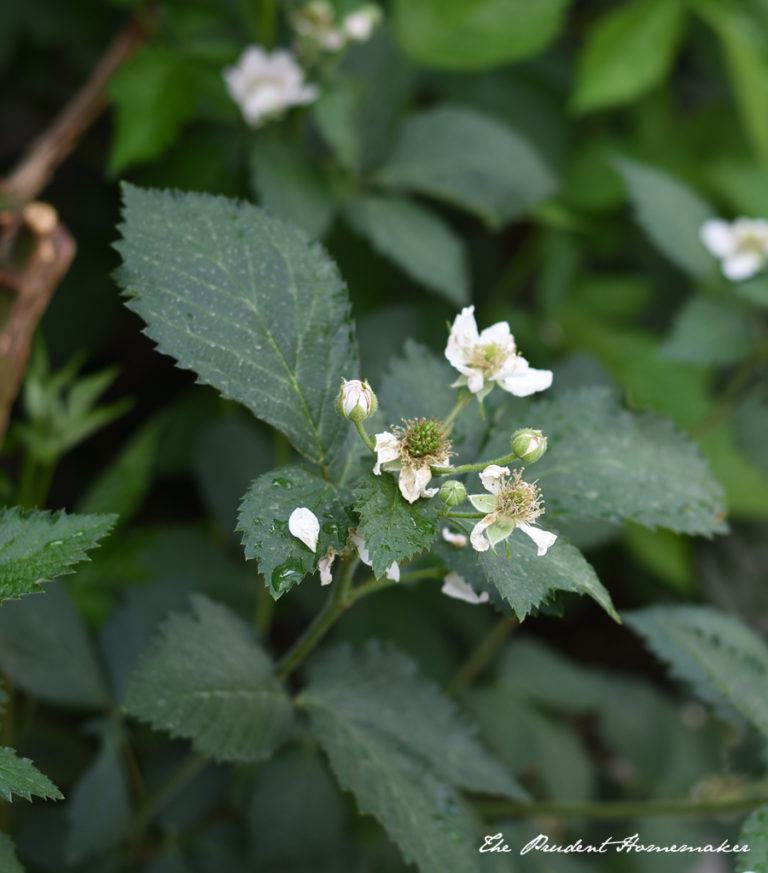

What do you do with your thinned fruit? I would think that much fruit would mess with the ph of my compost. Any ideas?
Thank you so much for this tutorial, Brandy! Reading about your small backyard orchard has inspired me, but I wondered about how to grow and care for the fruit trees. This post answered a lot of my questions. The information you’ve provided, your explanations on why and visual photographic reference on how to do it will come in really handy when I am ready to plant my own small orchard. Thanks again for sharing your wisdom and experience with us!
I throw it in the trash. There are lots of pits in there that aren’t going to break down in compost.
Great post – something I’d never have thought of and I appreciate the acknowledgement of how painful thinning is LOL!
This was soooo helpful! Thank you!
Thanks for the information, Brandy. Hopefully this year we won’t get a frost after the trees set their buds and I’ll be able to use your information. 🙂
Thanks for the blog and all the helpful information. You might find this book helpful. I just found it at my local library. It is for backyard orchards.
http://www.amazon.com/Grow-Little-Fruit-Tree-Easy-Harvest/dp/1612120547
Thank you so much for your service with this blog. You have inspired me greatly! Because of you I have my own garden now for the third year and can really see the benefits not only on my grocery budget but on our health. I have planted many things from seeds this year and that really keeps the cost down. On your advice I have planted flowers just for the purpose of cutting and bringing in the house. I guess I need to add thinning my pear and apple trees to my to do list. Thank you for introducing me to my favorite hobby.
Did you take courses in horticulture? You are so knowledgeable about trees,plants,etc.
We don’t have fruit trees, but I had to mention that my mouth nearly foamed at the picture of those apricots!! My friend had a tree when we lived in the L.A. area & it produced like crazy. Once you’ve had a delicious homegrown apricot, there’s no going back to the market for them! I don’t think I’ve had one in more than 10 yrs.
Debby
Thank you so much Brandy! I “inherited” a small apple orchard from my in-laws, who have just let it sit w/o pruning or other maintenance. Last year the apples were very small, and my in-laws have had problems with branches breaking on pears. Maybe thinning will help. Thanks a ton! I love your site.
Could you use it for animal feed??
Maybe! They’re green, though; in humans eating unripe fruit can result in a stomachache. I don’t know about animals. I know the wild birds won’t touch the fruit when it is this young. They don’t come near it until it is less than a week towards being ripe.
Pruning will help, too. Definitely prune them this year. Too much shade won’t help your apples if they have so many branches that they can’t get sunlight. You should be able to pass a football through the center of the tree when it is dormant. If not, you’ve got too many branches. Cut them out to help sunlight and air get to your fruit!
I smiled when you said, “It will hurt your feelings to do this…” because you are right!
Thank you for this post, Brandy. We have not been very good about thinning our fruit trees. You’re so right, it does hurt our feelings to do so, but this encourages me to be better about this. A late freeze unfortunately thinned out almost all of our peaches this year, but pears and apples are looking good so far, so I do have some to work with.
Oh my. Yep, it would make me ‘sick’ to pull all that fruit off. Good to know though if I ever get fruit trees.
I agree that thinning is very important and I’m in total agreement with your methods in a backyard situation. I wanted to share a funny “thinning” story with you.
Growing up, and then working for years on a family orchard u-pick farm, we had acres of peaches to thin. So, when I was around highschool age, a “new” method was introducted by some of the farmers and we began to use it. We got wiffle (plastic) bats and then hit the small peaches off the trees where there were too many. As silly as I’m sure we looked, it really worked and that method is still being used almost 40 years later by other relatives who still maintain orchards. It’s amazing how accurate we became and how you can learn to flick off the ones you don’t want with much more control than you would believe. If you had a large amount of peach trees, I would recommend doing it. Before that, I can remember painstakingly picking off the extra small, green peaches one by one. The bat method is much quicker, but not quite as gentle on the tree or fruit. Occasionally, a deformed peach will result, because it got broken while small. When asked what caused the deformity, we simply replied “bat damage.” 🙂
I know this method won’t work for apples or pears, though. They are not attached in the same way to the tree.
Becky,
I wish I heard about the bat method when I was a kid thinning our peach tree orchard! I would itch so bad from the peach fuzz! I grew up in Hood River, OR. We had orchards of peaches, nectarines, pears, apples, and cherries. Oh how I wish I still had access to all that free, scrumptious fruit!
Brandy, thank you so much for your blog and all the information I have learned. You and all your responders are such an inspiration. I am addicted to reading your blog!
This is helpful. And you’re right it will/would hurt my feelings and if I haven’t seen previous pictures of your bounties, I would not be able to agree – nope just wouldn’t happen. 🙂 Our property is loaded with shade trees – to the point where 25% had to come down due to the original owners over crowded plantings. There is enough room for a small fruit tree on our side yard (to do well) and of course I wanted one after we had the mentioned cut down. It has been a few years and now my husband is finally accepting that there will be a pear or apricot tree planted soon. Now I know how to do it right – so thank you!
I love your blog! Thank you for doing things with such simple elegance.
Thank you for this very helpful post. This explains why our Native Plum tree fruit is small.
Your blog posts are wonderful.
Maria, thanks for the link! This book looks like just what I need.
Brandy, I agree with the comments. This is a great post. I don’t have fruit trees so have no real need to know this but between the photos and explanations I was spellbound. I could actually understand what was needed. Many time, folks with lots of experience in an area give an explanation way over my head. This topic was interesting and informative. Thanks 😉
I just can’t do it Brandy! I don’t even care for peaches but they’re so darn cute. Our overcrowding is not so bad, our bigger issue is we have hundreds of peaches and not one of us likes to eat them. It must be genetic. This year I’ll be looking for gleaners to clear them.
JUST YESTERDAY I was wondering how to do this! Thanks much!
I took a lot of classes from the local extension service in 2001 and 2002.
Bravo for a great (and painful) writeup on fruit thinning.
Don’t compost them. When they are that small either drop them to the ground (they represent no pest carryover threat) to feed the tree, or collect and pickle them to eat like grapes or olives (your pickling recipes). When they are dime/nickle sizes the stone or seeds have not developed hard yet and can be eaten whole. Try a small batch next year when it is thinning time.